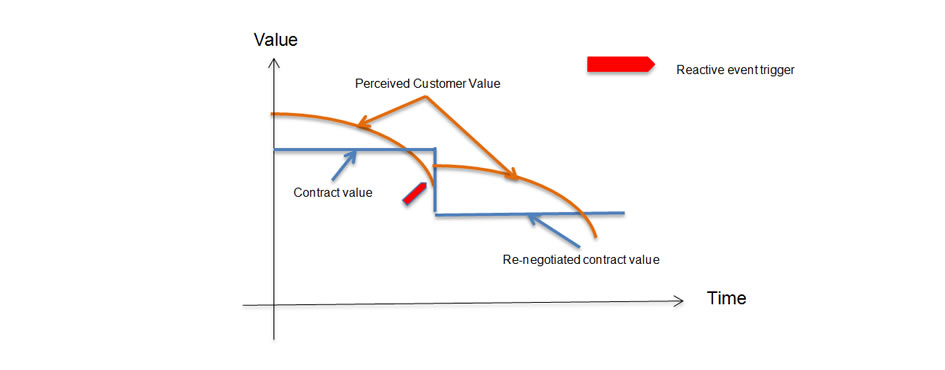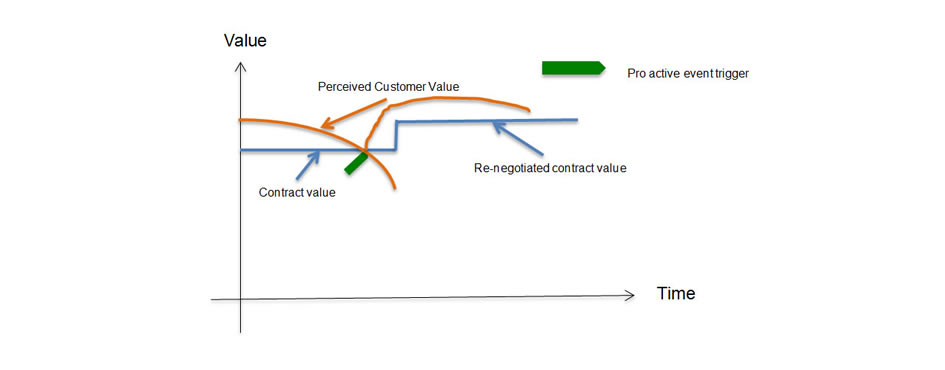Project Description
Value Added Erosion
Combating Value Added Erosion

Whether a customer has invested in a Product, System, Infrastructure etc, service is always important. It is important for the customers in order to keep the equipment running as well as possible and it is important for the supplier as on-going customer contact as well as income.
In this article I am going to look at service in an industrialised environment. Many customers do not possess the in-house knowledge to maintain and keep the new system technology running, or due to market liberalization does not want to. A great many companies are outsourcing service or creating partnering JV to handle this and a great many companies have service as an additional offering or is specialised in this business.
Winning the service contract is great, but we must be aware that the customer’s perception of the value of the contract is likely to erode over time. Why is that? It has to do with the psychology of habits. It is about getting used to something. At a service contract’s start the customer can easily identify why they chose a certain company to award the contract to. It was clear that there were certain differentiators that had a certain value. Over time these differentiators become an expected part of doing business, it becomes normal.At some point the customer will reconsider how to execute service, which may result in the loss of the contract or intense margin pressure at the time of renewal.
Simply put, the customer’s perceived value can erode from the start of the contract. By refreshing the contract with new added value, Your Company can maintain the customer’s satisfaction. The following is not theory, but a real day-to-day business approach that has been developed successfully by many successful service providers. It is example from over 100 different service contracts worldwide.
First phase: Customer is happy with contract
One possible start into service business is that new and unknown (for a specific customer) technology creates fear in the customer’s organisation, and creates: high willingness to invest in expert know-how and support, Customer perception of Value Added is much higher than contracted value, which creates an initial win-win situation. This is the psychological buying behaviour of “I have gotten a really good deal”

As time passes the feeling of value added starts to diminish (erode). The customer gets used to a certain level of service. The result is that basically with each day the customer is more likely to feel less warm about the value added. This triggers a normal psychological behaviour “I am paying too much”. Discussion about cost reduction/margin pressure is the most likely result, the customer is the acting party and the service provider is put in reactive/weak position! This is the start to the second Phase
Second phase: The customer approach’s the service provider and new negotiations start that`s in such cases end`s with a is a renegotiated contract with a lower value!!!!!!!!!!!!!!!!!!!!!
This is now obviously the start of a downward spiral that ends with separation. What started out positive has turned into a negative relationship that ends with no winners, only looser. The customer needs to start all over again and the service provider has contracted less. In most cases it is agreed in both organisations “it was good that it finally ended. This had been going the wrong way for much too long”
Third Phase: The services provider takes strategic action to add new value and thereby avoids downward spiral.
Timing is the key; we must act before the customer makes us react!!!!!!!!!!!!!!!!!

Creative approaches can lead to a win-win-situation. Major actions/changes are proposed before the customer forces the issue. Proactively seek ways to add value to the customer in order to avoid the pitfalls that occur by reacting too late
Ways to new value for your customers!
What can be done? What are possible new values that can be created for the customer? The list is long and clearly site and customer specific. Having studied over 100 Service contracts over a 3 year period I found some common possibilities:
Information about cost, open book vs. Closed book, Think about manpower charges including holiday & sickness cover, support contracts including call-out costs, spare parts: Buy-back, consignment stock, supply chain management, provision of spares within the price, finance charges, recruitment & re-recruitment costs.
Engage in a dialog with the customer in order to find out what is of value to them, what might have change since the start of the contract? Have their market changed?
Likewise engage in dialog with the service people who work at the site, and find out what they know. Your service people should in this respect be your greatest date and information asset.
Think also about what can be done with respect to Infrastructure and tools. What new possibilities does technology give e.g. new improved conditioning and/or remote monitoring. You can think about the entire structure of the contract i.e. risk reward incentivise KPI`s so that the customer pays you more when the equipment can produce more or have a higher through put Finally I am inviting you to think about new/other ways of doing not only service business, but business in general. Think about what value you are creating for all involved, and what additional values can be created. Also please do so before the customer or your competition forces you to react.
Cutting your margins and see how you can take additional cost out of your operation is not a long-term recipe for creating value. You always need to have your cost under control it is however not enough. Only doing that is a downward spiral that is accelerating the value added erosion. And it’s not rocket science nor is it something that accidental falls into your lap. It is hard and diligent work every day. The good part about it is that you create value for all involved!!!!!!!!!
